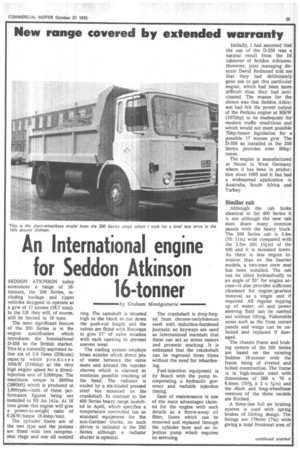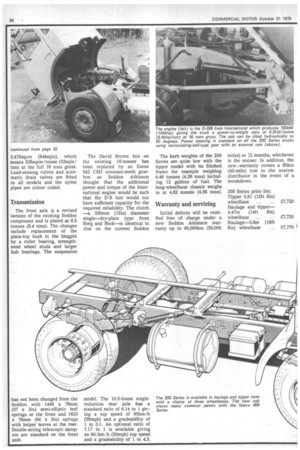An International engine for Seddon Atkinson 16-tonner
Page 37

Page 38

If you've noticed an error in this article please click here to report it so we can fix it.
by Graham
Montgornerie 1•11■■••••■
SEDDON ATKINSON today announces a range of 16tanners, the 200 Series, including haulage and tipper vehicles designed to operate at a gvw of 17 tonnes (16.7 tons). In the UK they will, of course, still be limited to 16 tons.
The most significant feature of the 200 Series is in the engine specification which introduces the International D-358 to the British market. This is a naturally aspirated inline six of 5.8 litres (358cuin) capac:ty which produces 100kW (134bhp) at the very high engine speed for a directinjection unit of 3,000rpm. The maximum torque is 360Nm (2661bft) which is produced at 1,600rpm—both of these performance figures being net installed to BS Au 141a. At 16 tons gross this engine will give a power-to-weight ratio of 6.2kW/tonne (8.4bhp/ton).
The cylinder 'liners are of the wet type and the pistons are fitted with two compression rings and one oil control ring. The camshaft is situated high in the block to cut down the push-rod length and the valves are fitted with Rotocaps to give 17° of valve rotation with each opening to prevent uneven wear.
The cooling system employs brass nozzles which direct jets of water between the valve seats and around the injector sleeves which is claimed 'to minimise possible cracking of the head. The radiator is cooled by a six-bladed pressed steel fan mounted on the crankshaft. In contrast to the 400 Series heavy range launched in April, which specifies a temperature controlled fan as standard equipment for the non-Gardner trucks, no such device is included in •the 200 Series although a radiator shutter is optional. The crankshaft is drop-forged from chrome-molybdenum steel with induction-hardened journals; no keyways are used as International maintain that these can act as stress raisers and promote cracking. It is estimated that the crankshaft can be reground three times without the need for rehardening.
Fuel-injection equipment is by Bosch with the pump incorporating a hydraulic governor and variable injection timing.
Ease of maintenance is one of the main advantages claimed for the engine With such details as •a throw-away oil filter, liners which can be removed and replaced through the cylinder bore and an injection pump which requires no servicing. Initially, I had assumed' that the use of the D-358 was a natural result from the IH takeover of Seddon Atkinson. However, joint managing director David Redmond told me that they had deliberately gone out to get this particular engine, which had been more difficult than they had anticipated. The reason for the choice was that Seddon Atkinson had felt the power output of the Perkins engine at 80kW (107bhp) to be inadequate for modern traffic conditions and which would not meet possible 7bhp/tonne legislation for a possible 17 tonnes gvw. The D-358 as installed in the 200 Series provides over 8bhp/ tonne.
The engine is manufactured at Neuss in West Germany where it has been in production since 1965 and it has had a widespread application in Australia, South Africa and Turkey.
Similar cab
Although the cab look's identical to the 400 Series it is not although the new cab does share many common panels with the heavy truck. The 200 Series cab is 2.4m (7ft 1 lin) wide compared with the 2.5m (8ft 11,4 in) of the 400 and it is mounted lower. As there is less engine intrusion than on the heavier models, a two-man crew seat has been 'installed. The cab can be tilted hydraulically to an angle of 50° for engine access—it also provides sufficient clearance for engine/gearbox removal as a single unit if required. All regular topping up of water, oil and power steering fluid can be carried out without tilting. Vulnerable areas such as the front corner panels and wings can be unbolted and replaced if damaged.
The chassis frame and braking system of the 200 Series are based on the existing Seddon 16-tonner with the frame being of riveted and bolted construction. The frame is in high-tensile -steel with dimensions of 266 x 76 x 6.4mm (101/2 x 3 x %in) and the short and long-wheelbase versions of the three models are flitched.
A three-line full air braking system is used with spring brakes of Girling design. The linings are 178mm (7in) wide giving a total frictional area of 5,470sqcm (848sqin), which means 336sqcm/tonne (53sqin/ ton) at 'the full 16 tons gross. Load-sensing valves and automatic drain valves are fitted to all models and the nylon pipes are colour coded.
Transmission
The front axle is a revised version of the existing Seddon component and is plated at 6.5 tonnes (6.4 tons). The changes include replacement of the plain-top bush in the kingpin by a roller bearing, strengthened wheel studs and larger hub bearings. The suspension has not been changed from the Seddon with 1448 x 76mm (57 x 3in) semi-elliptic leaf springs at the front and 1625 x 76rrim (64 x sin) springs with helper leaves at the rear. Double-acting telescopic dampers •are standard on •the front axle. The David Brown box on the existing 16-tonner has been replaced by an Eaton 542 CMJ constant-mesh gearbox as Seddon Atkinson thought that the additional power and torque of the International engine would be such that the D-B box would not have sufficient capacity for the required reliability. The clutch —a 330mm (13in) diameter single—dry-plate type from Borg and Beck—is identical to that on the current Seddon model. The 10.5-tonne singlereduction rear axle has a standard ratio of 6.14 to 1 giving a top speed of 95km/h (59mph) and a gradeability of 1 in 5.1. An optional ratio of 7.17 to 1 is available giving an 80/km/h (50mph) top speed and a gradeability of 1 in 4.3. The kerb weights of the 200 Series are quite low with the tipper model with its flitched frame for example weighing 4.46 tonnes (4.39 tons) 'including 12 gallons of fuel. The long-wheelbase chassis weighs in at 4.62 tonnes (4.56 tons).
Warranty and servicing
Initial defects will be rectified free of charge tinder a new Seddon Atkinson warranty up to 80,000km (50,000 miles) or 12 months, whichever is the sooner. In addition, the new ,warranty covers a 65km (40-mile) tow to the nearest distributor in the event of a breakdown.
200 Series price list: Tipper 3.81 (12ft 6in) wheelbase . £7,720 Haulage and tipper4.47m (14ft 8in) wheelbase ... .. £7,720 Haulage-5.6m (18ft 6in) wheelbase ... £7,770
































































































